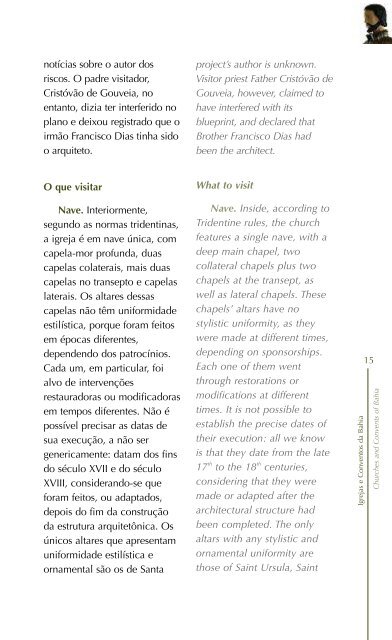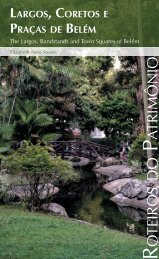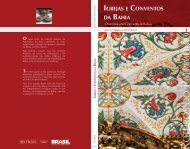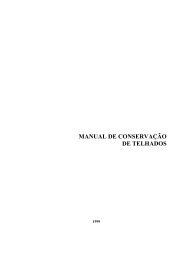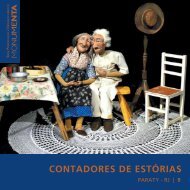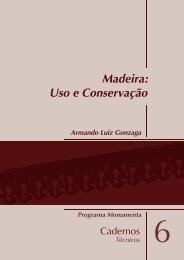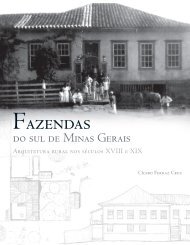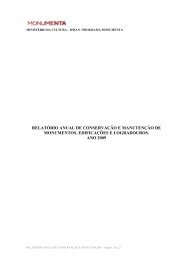Igrejas e Conventos da Bahia - Monumenta
Igrejas e Conventos da Bahia - Monumenta
Igrejas e Conventos da Bahia - Monumenta
Create successful ePaper yourself
Turn your PDF publications into a flip-book with our unique Google optimized e-Paper software.
notícias sobre o autor dos<br />
riscos. O padre visitador,<br />
Cristóvão de Gouveia, no<br />
entanto, dizia ter interferido no<br />
plano e deixou registrado que o<br />
irmão Francisco Dias tinha sido<br />
o arquiteto.<br />
O que visitar<br />
Nave. Interiormente,<br />
segundo as normas tridentinas,<br />
a igreja é em nave única, com<br />
capela-mor profun<strong>da</strong>, duas<br />
capelas colaterais, mais duas<br />
capelas no transepto e capelas<br />
laterais. Os altares dessas<br />
capelas não têm uniformi<strong>da</strong>de<br />
estilística, porque foram feitos<br />
em épocas diferentes,<br />
dependendo dos patrocínios.<br />
Ca<strong>da</strong> um, em particular, foi<br />
alvo de intervenções<br />
restauradoras ou modificadoras<br />
em tempos diferentes. Não é<br />
possível precisar as <strong>da</strong>tas de<br />
sua execução, a não ser<br />
genericamente: <strong>da</strong>tam dos fins<br />
do século XVII e do século<br />
XVIII, considerando-se que<br />
foram feitos, ou a<strong>da</strong>ptados,<br />
depois do fim <strong>da</strong> construção<br />
<strong>da</strong> estrutura arquitetônica. Os<br />
únicos altares que apresentam<br />
uniformi<strong>da</strong>de estilística e<br />
ornamental são os de Santa<br />
project’s author is unknown.<br />
Visitor priest Father Cristóvão de<br />
Gouveia, however, claimed to<br />
have interfered with its<br />
blueprint, and declared that<br />
Brother Francisco Dias had<br />
been the architect.<br />
What to visit<br />
Nave. Inside, according to<br />
Tridentine rules, the church<br />
features a single nave, with a<br />
deep main chapel, two<br />
collateral chapels plus two<br />
chapels at the transept, as<br />
well as lateral chapels. These<br />
chapels’ altars have no<br />
stylistic uniformity, as they<br />
were made at different times,<br />
depending on sponsorships.<br />
Each one of them went<br />
through restorations or<br />
modifications at different<br />
times. It is not possible to<br />
establish the precise <strong>da</strong>tes of<br />
their execution: all we know<br />
is that they <strong>da</strong>te from the late<br />
17 th to the 18 th centuries,<br />
considering that they were<br />
made or a<strong>da</strong>pted after the<br />
architectural structure had<br />
been completed. The only<br />
altars with any stylistic and<br />
ornamental uniformity are<br />
those of Saint Ursula, Saint<br />
<strong>Igrejas</strong> e <strong>Conventos</strong> <strong>da</strong> <strong>Bahia</strong><br />
15<br />
Churches and Convents of <strong>Bahia</strong>


